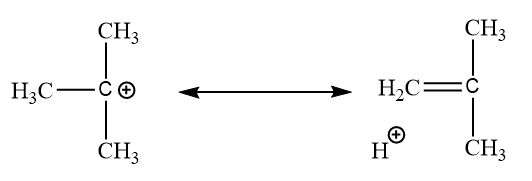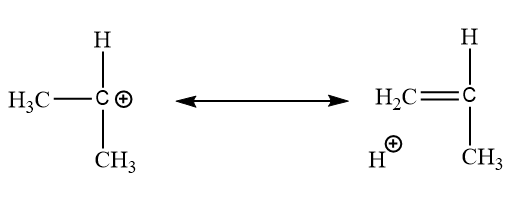
How can inductive and hyperconjugation effects explain the stability of primary, secondary and tertiary carbocation?
Answer
465.9k+ views
Hint: Those species in which a carbon atom is having positive charge are known as carbocations. In these species there is a deficiency of electrons and has planar structure. Carbocations are of three types:
Primary carbocation $\left( {{1^ \circ }} \right)$
Secondary carbocation $\left( {{2^ \circ }} \right)$
Tertiary carbocation $\left( {{3^ \circ }} \right)$
Complete answer:
These compounds have positively charged carbon atoms. In other words, carbon atoms consist of a positive charge and have three bonds. In simple words, they are carbon cations. Nowadays, it is explained as any even-electron cation which has a remarkable positive charge on the carbon atom.
There are two main norms for the stability of the carbocation which are the inductive effect and the second is hyperconjugation effect.
Inductive effect $\left( { + I} \right)$: Some compounds have a tendency to donate their electrons, this tendency to donate is termed as inductive effect. Alkyl groups have positive inductive effects. Thus, in tertiary carbocations, they have three alkyl groups that apply the $ + I$ effect while secondary carbocations consist of two alkyl groups. Therefore tertiary is more stable than secondary and secondary is more stable than primary.
${3^ \circ }\,carbocation \succ {2^ \circ }\,carbocation \succ {1^ \circ }\;carbocation$
Hyperconjugation effect: in this effect, there is delocalization of electrons taking place with the participation of $\sigma $ bonds. Alternatively known as sigma bond resonance. The stability of carbocation is directly proportional to hyperconjugation. The more hyperconjugation, the more will be the stability of carbocation.
In tertiary carbocation:

Here this type of hyperconjugation can have a total of nine structures.
In secondary carbocation:

In this type of sigma bond resonance, there are only six structures.
Thus, tertiary carbocation is more stable than secondary and secondary carbocation is more stable than primary.
Note:
Tertiary carbocations consist of three alkyl groups whereas secondary carbocation is those which have two alkyl groups. Primary carbocation has only one type of carbocation that is methyl carbocation which does not contain an alkyl group that can be attached to the carbocation.
Primary carbocation $\left( {{1^ \circ }} \right)$
Secondary carbocation $\left( {{2^ \circ }} \right)$
Tertiary carbocation $\left( {{3^ \circ }} \right)$
Complete answer:
These compounds have positively charged carbon atoms. In other words, carbon atoms consist of a positive charge and have three bonds. In simple words, they are carbon cations. Nowadays, it is explained as any even-electron cation which has a remarkable positive charge on the carbon atom.
There are two main norms for the stability of the carbocation which are the inductive effect and the second is hyperconjugation effect.
Inductive effect $\left( { + I} \right)$: Some compounds have a tendency to donate their electrons, this tendency to donate is termed as inductive effect. Alkyl groups have positive inductive effects. Thus, in tertiary carbocations, they have three alkyl groups that apply the $ + I$ effect while secondary carbocations consist of two alkyl groups. Therefore tertiary is more stable than secondary and secondary is more stable than primary.
${3^ \circ }\,carbocation \succ {2^ \circ }\,carbocation \succ {1^ \circ }\;carbocation$
Hyperconjugation effect: in this effect, there is delocalization of electrons taking place with the participation of $\sigma $ bonds. Alternatively known as sigma bond resonance. The stability of carbocation is directly proportional to hyperconjugation. The more hyperconjugation, the more will be the stability of carbocation.
In tertiary carbocation:

Here this type of hyperconjugation can have a total of nine structures.
In secondary carbocation:

In this type of sigma bond resonance, there are only six structures.
Thus, tertiary carbocation is more stable than secondary and secondary carbocation is more stable than primary.
Note:
Tertiary carbocations consist of three alkyl groups whereas secondary carbocation is those which have two alkyl groups. Primary carbocation has only one type of carbocation that is methyl carbocation which does not contain an alkyl group that can be attached to the carbocation.
Recently Updated Pages
How many different arrangements can be made by using class 11 maths CBSE

What is the difference between free and forced vib class 11 physics CBSE

Why is clavicle bone called beauty bone class 11 biology CBSE

Which of the following is isooctane A B C D None class 11 chemistry CBSE

Write a stanza wise summary of money madness class 11 english CBSE

Convert 1 radian into a degree minute and second class 11 maths CBSE

Trending doubts
10 examples of friction in our daily life

One Metric ton is equal to kg A 10000 B 1000 C 100 class 11 physics CBSE

Difference Between Prokaryotic Cells and Eukaryotic Cells

1 Quintal is equal to a 110 kg b 10 kg c 100kg d 1000 class 11 physics CBSE

State the laws of reflection of light

Explain zero factorial class 11 maths CBSE




